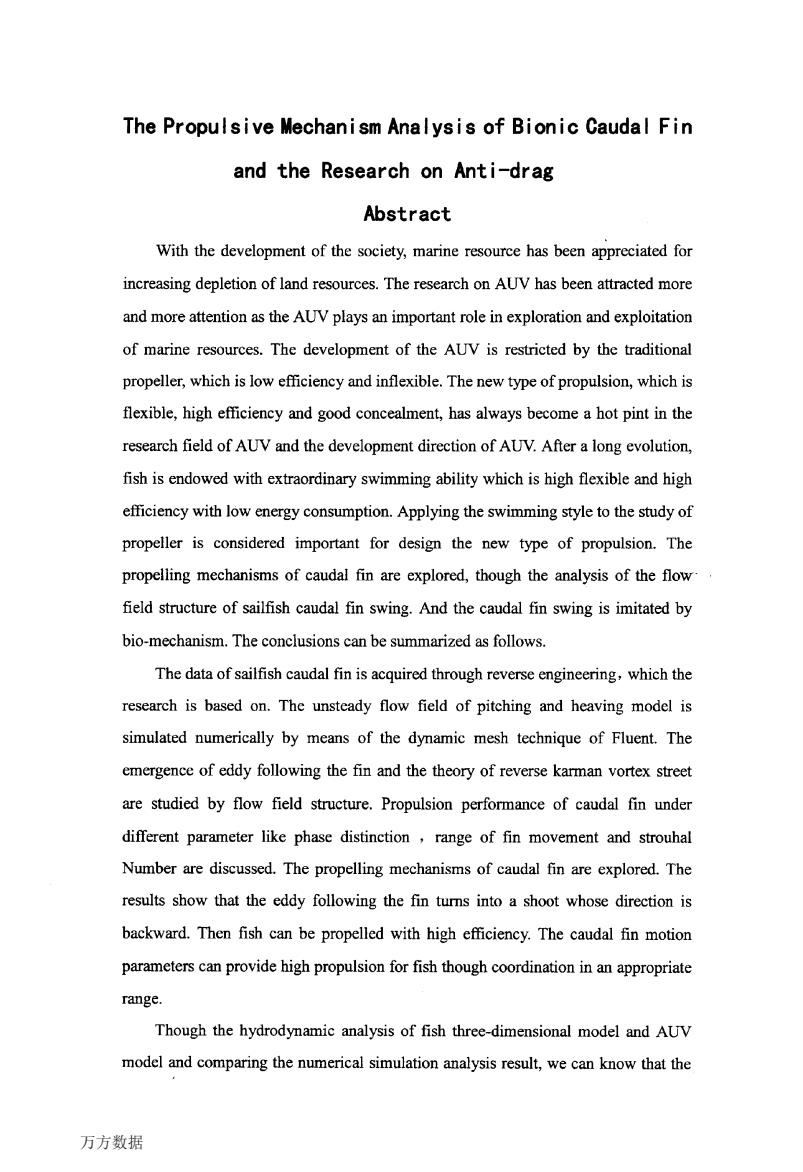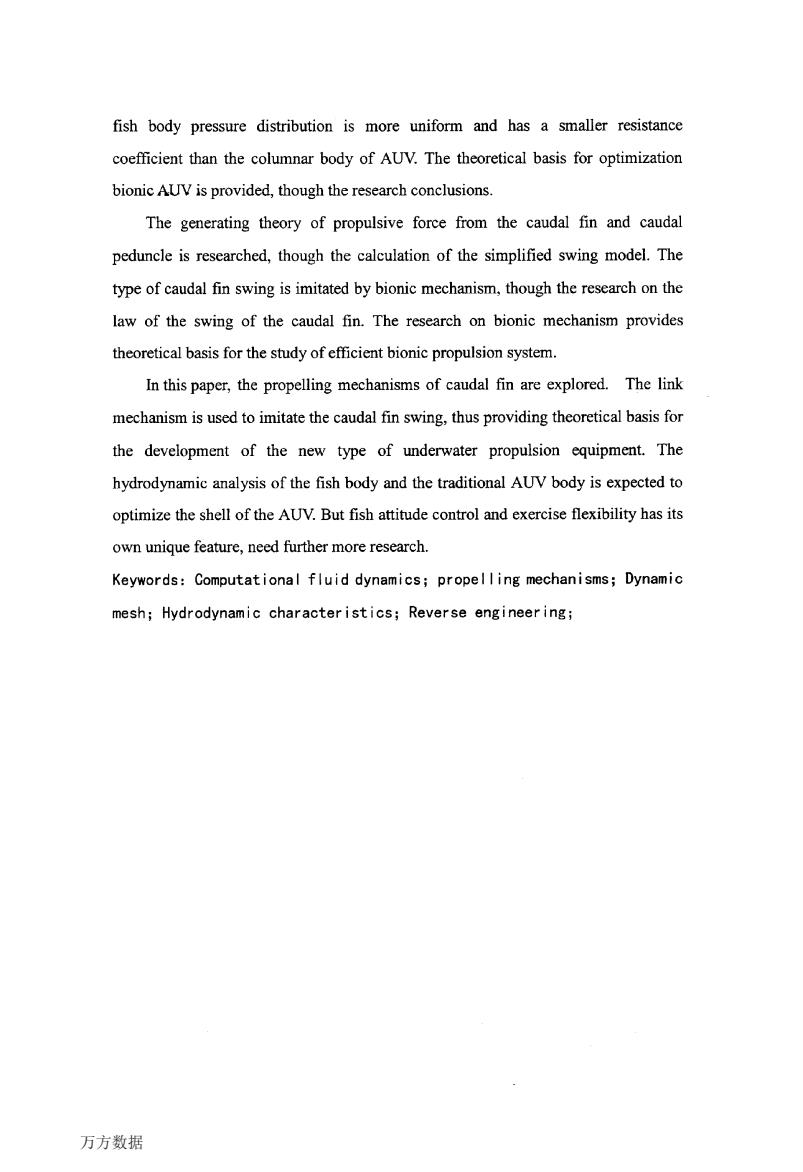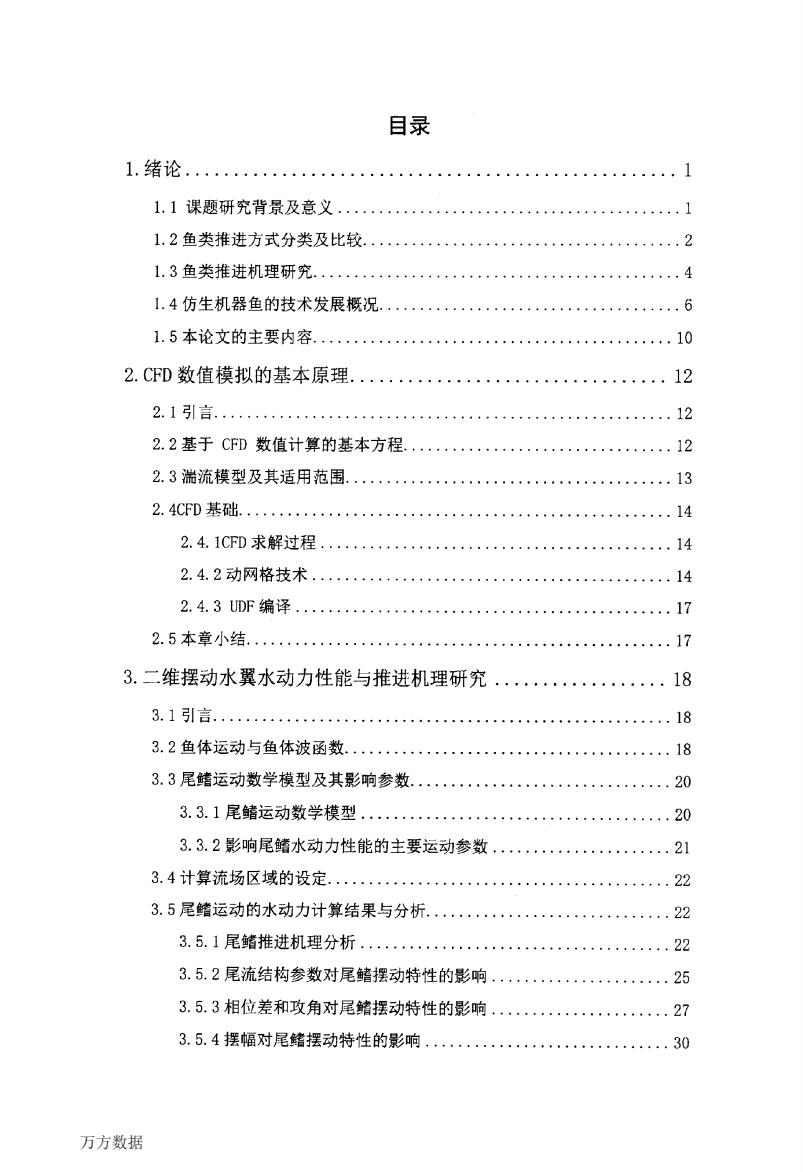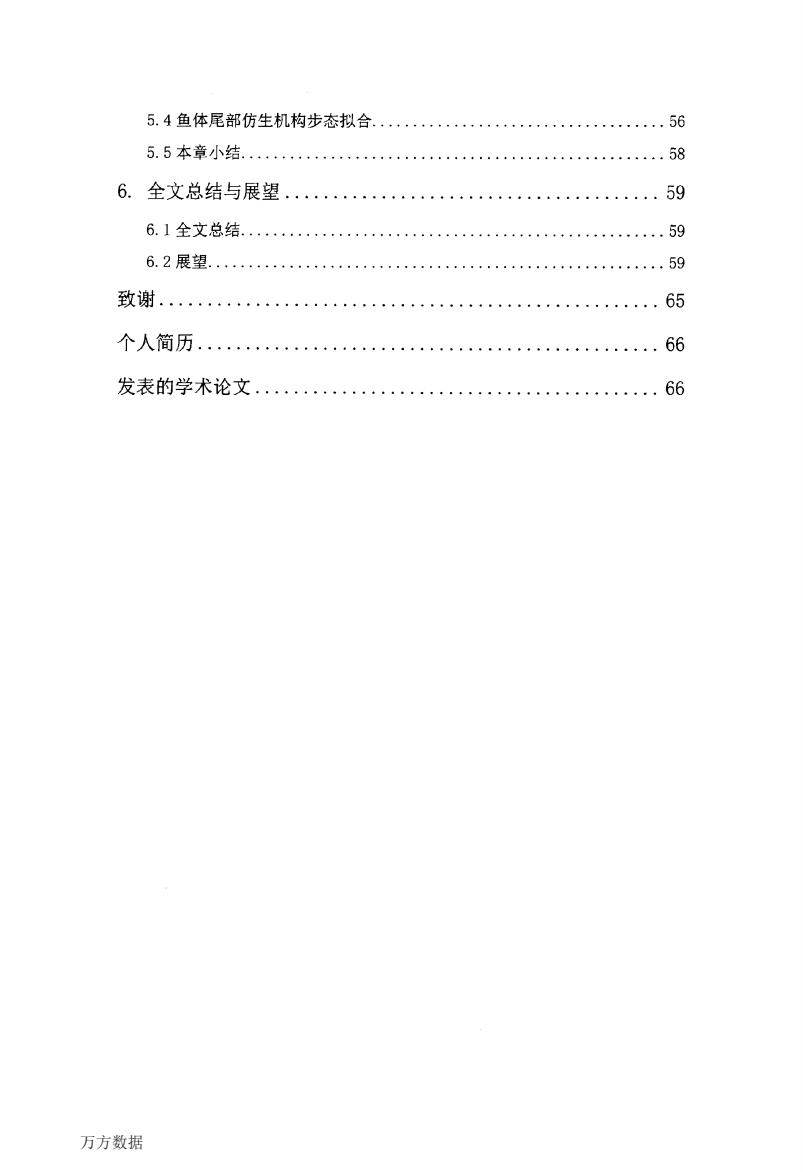
The Propulsive Mechanism Analysis of Bionic Caudal Fin and the Research on Anti-drag Abstract With the development of the society,marine resource has been appreciated for increasing depletion of land resources.The research on AUV has been attracted more and more attention as the AUV plays an important role in exploration and exploitation of marine resources.The development of the AUV is restricted by the traditional propeller,which is low efficiency and inflexible.The new type of propulsion,which is flexible,high efficiency and good concealment,has always become a hot pint in the research field of AUV and the development direction of AUV.After a long evolution, fish is endowed with extraordinary swimming ability which is high flexible and high efficiency with low energy consumption.Applying the swimming style to the study of propeller is considered important for design the new type of propulsion.The propelling mechanisms of caudal fin are explored,though the analysis of the flow field structure of sailfish caudal fin swing.And the caudal fin swing is imitated by bio-mechanism.The conclusions can be summarized as follows. The data of sailfish caudal fin is acquired through reverse engineering,which the research is based on.The unsteady flow field of pitching and heaving model is simulated numerically by means of the dynamic mesh technique of Fluent.The emergence of eddy following the fin and the theory of reverse karman vortex street are studied by flow field structure.Propulsion performance of caudal fin under different parameter like phase distinction range of fin movement and strouhal Number are discussed.The propelling mechanisms of caudal fin are explored.The results show that the eddy following the fin turns into a shoot whose direction is backward.Then fish can be propelled with high efficiency.The caudal fin motion parameters can provide high propulsion for fish though coordination in an appropriate range. Though the hydrodynamic analysis of fish three-dimensional model and AUV model and comparing the numerical simulation analysis result,we can know that the 万方数据
The Propu I S i ve Mechan i Sltl Ana I ys i S of B i on i C Cauda I F i n and the Research on Ant i。。drag Abstract With the development of the society,marine resource has been appreciated for increasing depletion of land resources.The research on AUV has been attracted more and more attention as the AUVplays ail important role in exploration and exploitation of marine resources.The development of the AUV is restricted by the traditional propeller,which is low efficiency and inflexible.The newtype of propulsion,which is flexible,high efficiency and good concealment,has always become a hot pint in the research field of AUV and the development direction of AUV.After a long evolution, fish is endowed with extraordinary swimming ability which is hi曲flexible and l'fi曲 efficiency with low energy consumption.Applying the swimming style to the study of propeller is considered important for design the new type of propulsion.The propelling mechanisms of caudal fm are explored,though the analysis of the flow field structure of sailfish caudal fin swing.And the caudal fin swing is imitated by bio.mechanism.The conclusions Can be summarized as follows. The data of sailfish caudal fin is acquired through reverse engineering,which the research is based on.The unsteady flow field of pitching and heaving model is simulated numerically by means of the dynamic mesh technique of Fluent.The emergence of eddy following the fin and the theory of reverse karman vortex street are studied by flow field structure.Propulsion performance of caudal fin under different parameter like phase distinction,range of fm movement and strouhal Number are discussed.The propelling mechanisms of caudal fin arc explored.The results show that the eddy following the fin turns into a shoot whose direction is backward.Then fish call be propelled with hi【gh efficiency.The caudal fin motion parameters Can provide high propulsion for fish though coordination in an appropriate range. Though the hydrodynamic analysis of fish three—dimensional model and则 model and comparing the numerical simulation analysis result,we can know that the 万方数据

fish body pressure distribution is more uniform and has a smaller resistance coefficient than the columnar body of AUV.The theoretical basis for optimization bionic AUV is provided,though the research conclusions. The generating theory of propulsive force from the caudal fin and caudal peduncle is researched,though the calculation of the simplified swing model.The type of caudal fin swing is imitated by bionic mechanism,though the research on the law of the swing of the caudal fin.The research on bionic mechanism provides theoretical basis for the study of efficient bionic propulsion system. In this paper,the propelling mechanisms of caudal fin are explored.The link mechanism is used to imitate the caudal fin swing,thus providing theoretical basis for the development of the new type of underwater propulsion equipment.The hydrodynamic analysis of the fish body and the traditional AUV body is expected to optimize the shell of the AUV.But fish attitude control and exercise flexibility has its own unique feature,need further more research. Keywords:Computational fluid dynamics;propelling mechanisms;Dynamic mesh;Hydrodynamic characteristics;Reverse engineering; 万方数据
fish body pressure distribution is more uniform and has a smaller resistance coefficient than the columnar body of AUV.The theoretical basis for optimization bionic AUV is provided,though the research conclusions The generating theory of propulsive force from the caudal fin and caudal peduncle is researched,though the calculation of the simplified swing model.The type of caudal fin swing is imitated by bionic mechanism,though the research on the law of the swing of the caudal fin.The research on bionic mechanism provides theoretical basis for the study of efficient bionic propulsion system In this paper,the propelling mechanisms of caudal fin are explored.The link mechanism is used to imitate the caudal fin swing.thus providing theoretical basis for the development of the new type of underwater propulsion equipment.The hydrodynamic analysis of the fish body and the traditional AUVbody is expected to optimize the shell of the AUV.But fish attitude control and exercise flexibility has its own unique feature,need further more research Keywords:ComputationaI fI ui d dynamiCS;propeI ng mechani sms;DynamiC mesh;Hydrodynam C character i st CS;Reverse eng neer ng 万方数据

目录 1.绪论.. 1.1课题研究背景及意义..· 1.2鱼类推进方式分类及比较...2 1.3鱼类推进机理研究...· 4 1.4仿生机器鱼的技术发展概况. 6 1.5本论文的主要内容.... ………10 2.CFD数值模拟的基本原理.... 12 2.1引言. 12 2.2基于CFD数值计算的基本方程 .12 2.3湍流模型及其适用范围.. 13 2.4CFD基础....· 2.4.1CFD求解过程...,· ....14 2.4.2动网格技术..· .14 2.4.3UDF编译. ..17 2.5本章小结. .17 3.二维摆动水翼水动力性能与推进机理研究.· 18 3.1引言.. 18 3.2鱼体运动与鱼体波函数...... 18 3.3尾鳍运动数学模型及其影响参数.… 20 3.3.1尾鳍运动数学模型.· 20 3.3.2影响尾鳍水动力性能的主要运动参数,....… 21 3.4计算流场区域的设定.……… 22 3.5尾鳍运动的水动力计算结果与分析.,..... 22 3.5.1尾鳍推进机理分析.……… 22 3.5.2尾流结构参数对尾鳍摆动特性的影响.… 25 3.5.3相位差和攻角对尾鳍摆动特性的影响… 27 3.5.4摆幅对尾鳍摆动特性的影响..30 万方数据
目录 1.绪论......…….…...…...…..…........……....1 1.1课题研究背景及意义.…………….…………….………l 1.2鱼类推进方式分类及比较…………….………………..…2 1.3鱼类推进机理研究………………….…………………..4 1.4仿生机器鱼的技术发展概况.………….…………………..6 1.5本论文的主要内容........…..........….…….............10 2.CFD数值模拟的基本原理..……...…...…….………12 2.1引言.....…..............................….....….......12 2.2基于CFD数值计算的基本方程…………………….……..12 2.3湍流模型及其适用范围………………………………….13 2.4CFD基础....……....….…...…..….…..…….……..14 2.4.1CFD求解过程.……...…...........….…….……..14 2.4.2动网格技术…..….……….…………………….14 2.4.3 UDF编译……………….…..………………….17 2.5本章小结….……….………………………………..17 3.二维摆动水翼水动力性能与推进机理研究………………18 3.1引言…..…………….………….………………....18 3.2鱼体运动与鱼体波函数………………………………….18 3.3尾鳍运动数学模型及其影响参数…………………………..20 3.3.1尾鳍运动数学模型…………….………………….20 3.3.2影响尾鳍水动力性能的主要运动参数………………….21 3.4计算流场区域的设定…….……….…………………….22 3.5尾鳍运动的水动力计算结果与分析………………….……..22 3.5.1尾鳍推进机理分析………………………………..22 3.5.2尾流结构参数对尾鳍摆动特性的影响………………….25 3.5.3相位差和攻角对尾鳍摆动特性的影响………………….27 3.5.4摆幅对尾鳍摆动特性的影响………………….……..30 万方数据

36双尾鳍在流体中推进性能的研究...32 3.6.1数值计算模型建立. 32 3.6.2动网格设置,· 33 3.6.3双尾鳍运动尾祸叠加模式...·......·. .34 3.6.4双尾鳍运动尾涡耗散模式...35 3.7本章小结,· 36 4.仿生体减阻水动力分析.. 38 4.1物体阻力产生机理.., 38 4.1.1航行器阻力基本概念..,… 38 41.2绕流阻力.… 39 4.2逆向工程获取旗鱼三维数据模型 40 4.2.1逆向工程介绍.... 40 4.2.2模型数据提取... 40 4.3简化模型.··…………· 44 4.4鱼体计算域及边界条件设置…… 44 4.4.1鱼体计算域的创建...44 4.42计算域的网格划分.44 4.4.3鱼体计算域的边界条件… .45 4.4.4回转型小型水下航行器的计算域及边界条件设置....45 4.5本章小结…… 5.尾部运动控制方法..·· 48 5.1尾部运动分析... ...48 5.1.2尾部运动数学分析……………… 49 5.1.3尾部运动模型建立· 50 5.2尾部运动动力学模型的建立. 51 5.2.1推进力分析..51 5.2.2鱼体所受阻力分析,. 52 5.2.3推进力的计算..,. 53 5.3鱼体尾部摆动的仿生机构设计.., …55 万方数据
3.6双尾鳍在流体中推进性能的研究…..……………….….….32 3.6.1数值计算模型建立………………………………..32 3.6.2动网格设置………………………..……………33 3.6.3双尾鳍运动尾涡叠加模式.………….………………34 3.6.4双尾鳍运动尾涡耗散模式………….……….………35 3.7本章小结….......…...............…..…..…...…....36 4.仿生体减阻水动力分析….....….......一.…....…...38 4.1物体阻力产生机理……………….…………………….38 4.1.1航行器阻力基本概念……………………….……..38 4.1.2绕流阻力………………………….……………39 4.2逆向工程获取旗鱼三维数据模型…………………………..40 4.2.1逆向工程介绍…..……….………………………40 4.2.2模型数据提取…….…….……………….……...40 4.3简化模型…….……..…….……….….…………….44 4.4鱼体计算域及边界条件设置………………………………44 4.4.1鱼体计算域的创建………………………..……...44 4.4.2计算域的网格划分………………………………..44 4.4.3鱼体计算域的边界条件…………………………….45 4.4.4回转型小型水下航行器的计算域及边界条件设置…………45 4.5本章小结.…......……………………………………47 5.尾部运动控制方法............….…......….....…..48 5.1尾部运动分析….…….…………….………..……….48 5.1.2尾部运动数学分析……….…….…………………49 5.1.3尾部运动模型建立……….…………………..…..50 5.2尾部运动动力学模型的建立…………………………...…51 5.2.1推进力分析….………………………………….51 5.2.2鱼体所受阻力分析………………………………..52 5.2.3推进力的计算…………………………..……….53 5.3鱼体尾部摆动的仿生机构设计…………...…….…………55 万方数据

5.4鱼体尾部仿生机构步态拟合………… 56 5.5本章小结. 58 6.全文总结与展望 59 6.1全文总结. 59 6.2展望..… 59 致谢. 65 个人简历.… 66 发表的学术论文.. 66 万方数据
5.4鱼体尾部仿生机构步态拟合………………………………56 5.5本章小结………………….……….………………..58 6.全文总结与展望.…...….........…..…..……....59 6.1全文总结..…..........….….…….….....….……….59 6.2展望..….….....….....….........……..........……59 致谢….….…..…………...…....…….....……65 个人简历..……..…..….….....…...……………66 发表的学术论文.….…..…..…...….......…...…..66 万方数据